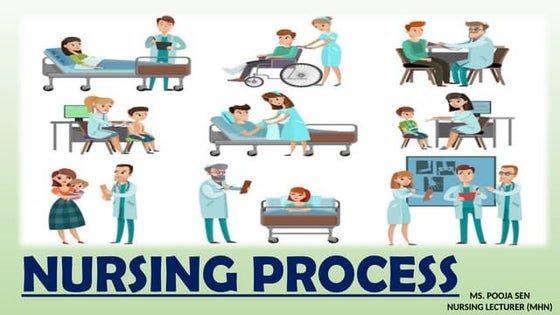Introduction of C Programming
Download as PPTX, PDF0 likes59 views
It consist the history of programming language and focus on the C- programming. The evolution of C- Programming and its advantages. It covers levels of programming languages ,compiler vs interpreter and also the different types of software.
1 of 17
Download to read offline


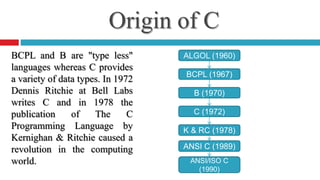



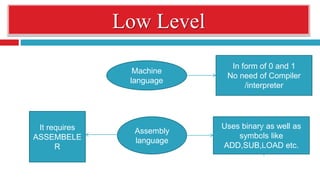
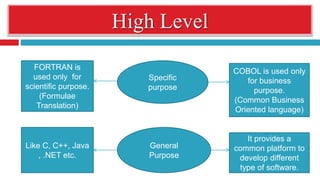
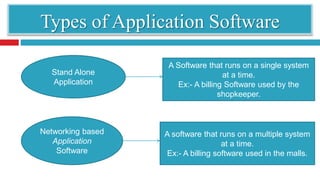
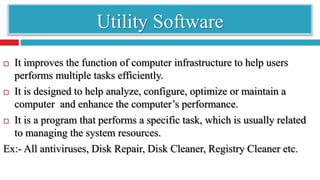
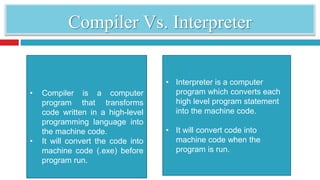

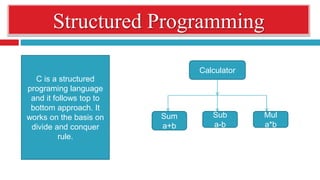

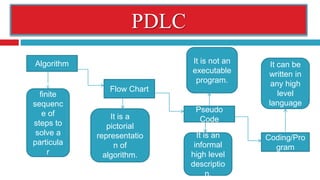
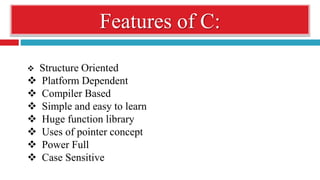

Recommended
Introduction to Programming Concepts By Aamir Saleem Ansari



Introduction to Programming Concepts By Aamir Saleem AnsariTech
╠²
Get the free powerpoint slide of introduction to programming concepts from Techora. Learn programming and other things from using our slides. For more visit : www.techora.net
This introductory slide program teaches you the foundational skills all programmers use, whether they program mobile apps, create web pages, or analyze data.
Computer programs are collections of instructions that tell a computer how to interact with the user, interact with the computer hardware and process data. The first programmable computers required the programmers to write explicit instructions to directly manipulate the hardware of the computer. This ŌĆ£machine languageŌĆØ was very tedious to write by hand since even simple tasks such as printing some output on the screen require 10 or 20 machine language commands. Machine language is often referred to as a ŌĆ£low level languageŌĆØ since the code directly manipulates the hardware of the computer.
By contrast, higher level languages such as ŌĆ£CŌĆØ, C++, Pascal, Cobol, Fortran, ADA and Java are called ŌĆ£compiled languagesŌĆØ. In a compiled language, the programmer writes more general instructions and a compiler (a special piece of software) automatically translates these high level instructions into machine language. The machine language is then executed by the computer. A large portion of software in use today is programmed in this fashion.Programming language



Programming languageMakku-Sama
╠²
Some of the programming languages and their developmental year.
The information used belong to their rightful owners
Copyright 2017ICT, Importance of programming and programming languages



ICT, Importance of programming and programming languagesEbin Robinson
╠²
This document discusses the importance of programming and programming languages. It provides definitions of computer programming and what programming languages are used for. It discusses why data types are important in programming languages. It also provides examples of popular software including Java, Android KitKat, and iOS.Lecture1 compilers



Lecture1 compilersAftab Ahmad
╠²
This document provides an introduction to a course on compiler construction. It outlines the goals of the course as learning how to build a compiler for a programming language, use compiler construction tools, and write different grammar types. It also discusses the grading policy, required textbook, and defines what a compiler is and provides examples of different compilers. It gives an overview of the phases and process of compilation from high-level language to machine code.Cw1



Cw1ahmadk1997
╠²
Computer programming involves analyzing problems, developing algorithms to solve them, implementing those algorithms in a programming language, and testing and debugging the resulting programs. There are many programming languages used for different purposes, with some of the most common being Python, C++, Java, and JavaScript. Programming allows humans to communicate instructions to computers and create programs that can control machine behavior.History of programming



History of programmingSharwin Calimlim
╠²
The document provides background information on programming languages and their history. It discusses early pioneers in computer programming such as Ada Lovelace, Herman Hollerith, and Konrad Zuse. It outlines the development of many popular modern programming languages such as Fortran, COBOL, BASIC, Pascal, C, C++, Java, PHP, JavaScript, Python, Ruby, and others, describing their key features and common uses. Ada Lovelace is noted as creating the first computer program in 1843 for Charles Babbage's analytical engine.Programming languages,compiler,interpreter,softwares



Programming languages,compiler,interpreter,softwaresNisarg Amin
╠²
The document discusses different types of programming languages and software. It describes low-level languages like machine language and assembly language, and high-level languages used for scientific and business applications. It also defines algorithms, flowcharts, compilers, interpreters, and system and application software.Computer



ComputerNewreborn Incarnation
╠²
The document discusses computer programming and provides details about:
- The process of programming which involves analysis, algorithm development, coding, and testing
- Common programming languages like C, C++, Java, and Python
- The roles of programmers and the different phases of programming like planning, coding, testing, and documentation
- Key aspects of programming like reliability, robustness, usability, portability, and maintainabilityIntroduction to c language 



Introduction to c language BAKRANIYA KALPESH
╠²
C is a procedural programming language initially developed in the early 1970s. It was largely developed as a system programming language to write operating systems. Many later languages have borrowed syntax and features from C. C is a general purpose language commonly used to write operating systems and is well-suited for both system software and business applications due to its efficiency and low-level access to memory. It combines features of both high-level and low-level languages.Introduction of c programming



Introduction of c programmingTarun Sharma
╠²
C is a general purpose, high-level programming language that was developed in the 1970s. It is widely used to create operating systems and is the precursor to many popular languages today. C code is compiled into machine-readable code that can be run on different computer systems. C has features like control structures, looping statements, arrays, and macros that make it well-suited for both business and scientific applications. It is commonly used to write operating systems like UNIX, Windows, Mac OS, and Linux.compiler vs interpreter



compiler vs interpreterFaculty of Science , portsaid Univeristy
╠²
This document compares interpreters and compilers. Both interpreters and compilers convert high-level programming code into machine-readable code, but they differ in how they accomplish this. Interpreters convert and execute code line-by-line, making debugging easier but programs slower. Compilers analyze the entire program at once before executing it, making programs faster but debugging more difficult. Examples of interpreters include JavaScript and BASIC, while C, C++, and Java are typically compiled languages.Ss ui lecture 1



Ss ui lecture 1Avinash Kapse
╠²
This document provides an overview of compilers and their functions. It discusses:
- The main phases of a compiler are analysis and synthesis. Analysis decomposes the source code into an intermediate representation, while synthesis generates the target program from that representation.
- Compilers translate human-oriented programming languages into machine languages to be executed by computers. They perform analysis of the source program and synthesis of machine-language code.
- Compilers generate different types of code like pure machine code, augmented machine code, or virtual machine code. They can also output assembly code or binary formats.Language translator



Language translatorasmakh89
╠²
The document discusses three programming language translators: assemblers translate assembly language into machine code, compilers translate high-level languages into executable object code, and interpreters execute instructions one at a time without producing an executable file. Assemblers convert mnemonics to machine language equivalents and assign addresses, compilers check syntax and generate all code at once, and interpreters check keywords and convert instructions individually to machine code.C programming



C programmingpreetikapri1
╠²
This document provides an overview of the C programming language. It discusses that C was developed at AT&T's lab by Dennis Ritchie and is a structured, portable, and reliable programming language. It then lists reasons for learning C like its use in operating systems and applications. The document outlines key features of C like portability, speed, and extensibility. It also describes the compilation process, data types, operators, and basic structure of a C program.Compiler vs Interpreter-Compiler design ppt.



Compiler vs Interpreter-Compiler design ppt.Md Hossen
╠²
This document presents a comparison between compilers and interpreters. It discusses that both compilers and interpreters translate high-level code into machine-readable code, but they differ in their execution process. Compilers translate entire programs at once during compilation, while interpreters translate code line-by-line at runtime. As a result, compiled code generally runs faster but cannot be altered as easily during execution as interpreted code. The document provides examples of compiler and interpreter code and outlines advantages of each approach.Programming Languages / Translators



Programming Languages / TranslatorsProject Student
╠²
Computer Science - Programming Languages / Translators
This presentation explains the different types of translators and languages of programming such as assembler, compiler, interpreter, bytecodeChapter 5



Chapter 5Hajar Len
╠²
The document discusses the basic concepts of programming including defining a program and programming language, levels of programming languages from low-level to high-level, common programming elements like variables and data types, and the key phases of program development from problem analysis to documentation.Introduction of c language



Introduction of c languageAkhilesh Maithani
╠²
The document discusses the C programming language. It defines what a programming language and machine language are. It describes the different types of programming languages including machine language, assembly language, and high-level languages. It discusses how programs in high-level languages need to be translated before execution through assemblers, interpreters, or compilers. It also covers the basic concepts of C like its features, character set, constants, variables, and keywords.Computer programming



Computer programmingVincent Valenzuela
╠²
Computer programming involves analyzing a computing problem, developing algorithms to solve it, implementing those algorithms in a programming language, and testing the resulting program. The purpose of programming is to automate tasks and solve problems. Programmers write computer software by performing tasks like coding, debugging, testing, and maintaining programs. Programming languages can be high-level or low-level, with high-level languages being more abstract but easier for humans to read and write.Programming content



Programming contentBazlin Ahmad
╠²
This document discusses basic programming concepts including defining a program and programming language. It describes different levels of programming languages from low-level machine languages to high-level languages like C++. It also covers structured and object-oriented programming approaches, translation methods like assemblers, interpreters, and compilers. The document outlines common control structures for sequencing and selecting execution flow. It then lists the typical phases of program development and basic elements in programming such as constants, variables, data types, and operators.Introduction to programming languages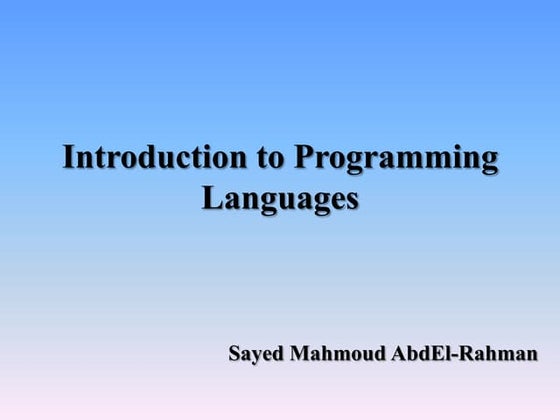



Introduction to programming languagesSayed Mahmoud AbdEl Rahman
╠²
This document provides an introduction to programming languages. It defines what a programming language and program are, explaining that a programming language allows programmers to write instructions for a computer in a coded language. It classifies languages as high-level or low-level and discusses how computers understand different languages. The document also addresses why we need programming languages, how to select a language for a problem, and gives an overview of the basic steps to write a computer program.Interpreter



InterpreterIGZ Software house
╠²
An interpreter is a program that directly executes instructions from a source program line-by-line. It translates each line of code into an intermediate form before executing it, rather than translating the whole program at once like a compiler. Interpreted languages execute more slowly than compiled languages since each line must be translated individually, but they allow for faster development and testing of programs. There are different types of interpreters that use various techniques for translating and executing code.Computer programming project 15sec



Computer programming project 15secJenny Brown
╠²
Computer programming involves using logic, algorithms, and programming languages to create software. Programmers use program code and tools like code editors, debuggers, and integrated development environments to write code. Popular programming languages provide commands and rules to develop executable programs. Compilers translate source code into object code, while interpreters translate code line-by-line. Application programming interfaces and software development kits are used to access operating systems and develop software for specific platforms.Introduction to Computer Programming



Introduction to Computer ProgrammingProf. Erwin Globio
╠²
1. The document introduces computer programming and discusses its importance in modern society. It touches on how computers have evolved to become indispensable tools that help solve problems across many domains.
2. It outlines the typical steps involved in programming: problem analysis, algorithm development, coding, testing and debugging. Key aspects like problem definition, input/output determination, and logical processing of data are important parts of problem analysis.
3. The document emphasizes that programming requires both logic and creativity to develop well-designed solutions. Proper documentation is also important for program maintenance and future modifications.Computer Language Translator



Computer Language TranslatorRanjeet Kumar
╠²
The document discusses different types of language translators including compilers, interpreters, and assemblers. A language translator converts source code into object code that computers can understand. Compilers convert an entire program into object code at once, while interpreters convert code line-by-line. Compilers are generally faster but require more memory, and errors are detected after compilation. Interpreters are slower but use less memory and can detect errors as they interpret each line.Programming Fundamentals lecture 1



Programming Fundamentals lecture 1REHAN IJAZ
╠²
This document provides information about programming fundamentals including definitions of computer hardware, software, operating systems, compilers, interpreters, source code, and text editors. It discusses how computer hardware refers to physical components like the monitor, keyboard, and CPU, and how software includes programs that direct the computer's processor. It also summarizes the differences between compilers and interpreters in processing source code.Ppt 1



Ppt 1Mohit Saini
╠²
The document provides an overview of the C programming language, including its history, characteristics, and structure. It discusses how C was developed in the 1970s at Bell Labs to program the UNIX operating system. It also summarizes key aspects of C like it being a middle-level language suitable for both systems and applications programming, its use of control structures for selection, repetition and loops, and its portability across operating systems.Programming Fundamentals and Programming Languages Concepts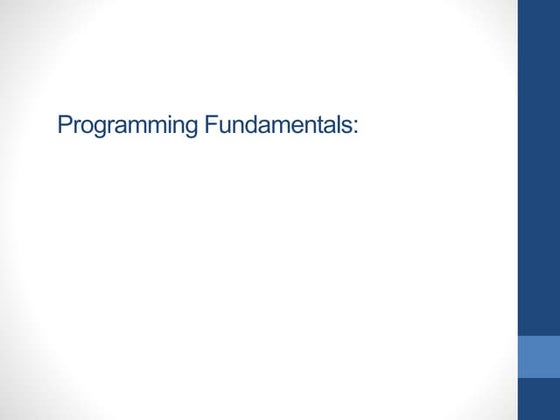



Programming Fundamentals and Programming Languages Conceptsimtiazalijoono
╠²
Programming Fundamentals:
What is a Computer?
Software & Hardware?
Operating System
Programming Languages Concepts
Why do we need programming languages?
Why C Still Useful?Presentation1



Presentation1SoorajYadav6
╠²
C++ and Java are two popular programming languages. C++ was developed by Bjarne Stroustrup in 1979 as an enhancement to C with object-oriented capabilities. Java was developed by James Gosling at Sun Microsystems in 1995 to be platform independent so applications can "write once, run anywhere". C was created by Dennis Ritchie between 1969-1973 at Bell Labs to be compiled with a straightforward compiler and provide low-level access to memory. It became widely popular due to its use in Unix operating systems.More Related Content
What's hot (20)
Introduction to c language 



Introduction to c language BAKRANIYA KALPESH
╠²
C is a procedural programming language initially developed in the early 1970s. It was largely developed as a system programming language to write operating systems. Many later languages have borrowed syntax and features from C. C is a general purpose language commonly used to write operating systems and is well-suited for both system software and business applications due to its efficiency and low-level access to memory. It combines features of both high-level and low-level languages.Introduction of c programming



Introduction of c programmingTarun Sharma
╠²
C is a general purpose, high-level programming language that was developed in the 1970s. It is widely used to create operating systems and is the precursor to many popular languages today. C code is compiled into machine-readable code that can be run on different computer systems. C has features like control structures, looping statements, arrays, and macros that make it well-suited for both business and scientific applications. It is commonly used to write operating systems like UNIX, Windows, Mac OS, and Linux.compiler vs interpreter



compiler vs interpreterFaculty of Science , portsaid Univeristy
╠²
This document compares interpreters and compilers. Both interpreters and compilers convert high-level programming code into machine-readable code, but they differ in how they accomplish this. Interpreters convert and execute code line-by-line, making debugging easier but programs slower. Compilers analyze the entire program at once before executing it, making programs faster but debugging more difficult. Examples of interpreters include JavaScript and BASIC, while C, C++, and Java are typically compiled languages.Ss ui lecture 1



Ss ui lecture 1Avinash Kapse
╠²
This document provides an overview of compilers and their functions. It discusses:
- The main phases of a compiler are analysis and synthesis. Analysis decomposes the source code into an intermediate representation, while synthesis generates the target program from that representation.
- Compilers translate human-oriented programming languages into machine languages to be executed by computers. They perform analysis of the source program and synthesis of machine-language code.
- Compilers generate different types of code like pure machine code, augmented machine code, or virtual machine code. They can also output assembly code or binary formats.Language translator



Language translatorasmakh89
╠²
The document discusses three programming language translators: assemblers translate assembly language into machine code, compilers translate high-level languages into executable object code, and interpreters execute instructions one at a time without producing an executable file. Assemblers convert mnemonics to machine language equivalents and assign addresses, compilers check syntax and generate all code at once, and interpreters check keywords and convert instructions individually to machine code.C programming



C programmingpreetikapri1
╠²
This document provides an overview of the C programming language. It discusses that C was developed at AT&T's lab by Dennis Ritchie and is a structured, portable, and reliable programming language. It then lists reasons for learning C like its use in operating systems and applications. The document outlines key features of C like portability, speed, and extensibility. It also describes the compilation process, data types, operators, and basic structure of a C program.Compiler vs Interpreter-Compiler design ppt.



Compiler vs Interpreter-Compiler design ppt.Md Hossen
╠²
This document presents a comparison between compilers and interpreters. It discusses that both compilers and interpreters translate high-level code into machine-readable code, but they differ in their execution process. Compilers translate entire programs at once during compilation, while interpreters translate code line-by-line at runtime. As a result, compiled code generally runs faster but cannot be altered as easily during execution as interpreted code. The document provides examples of compiler and interpreter code and outlines advantages of each approach.Programming Languages / Translators



Programming Languages / TranslatorsProject Student
╠²
Computer Science - Programming Languages / Translators
This presentation explains the different types of translators and languages of programming such as assembler, compiler, interpreter, bytecodeChapter 5



Chapter 5Hajar Len
╠²
The document discusses the basic concepts of programming including defining a program and programming language, levels of programming languages from low-level to high-level, common programming elements like variables and data types, and the key phases of program development from problem analysis to documentation.Introduction of c language



Introduction of c languageAkhilesh Maithani
╠²
The document discusses the C programming language. It defines what a programming language and machine language are. It describes the different types of programming languages including machine language, assembly language, and high-level languages. It discusses how programs in high-level languages need to be translated before execution through assemblers, interpreters, or compilers. It also covers the basic concepts of C like its features, character set, constants, variables, and keywords.Computer programming



Computer programmingVincent Valenzuela
╠²
Computer programming involves analyzing a computing problem, developing algorithms to solve it, implementing those algorithms in a programming language, and testing the resulting program. The purpose of programming is to automate tasks and solve problems. Programmers write computer software by performing tasks like coding, debugging, testing, and maintaining programs. Programming languages can be high-level or low-level, with high-level languages being more abstract but easier for humans to read and write.Programming content



Programming contentBazlin Ahmad
╠²
This document discusses basic programming concepts including defining a program and programming language. It describes different levels of programming languages from low-level machine languages to high-level languages like C++. It also covers structured and object-oriented programming approaches, translation methods like assemblers, interpreters, and compilers. The document outlines common control structures for sequencing and selecting execution flow. It then lists the typical phases of program development and basic elements in programming such as constants, variables, data types, and operators.Introduction to programming languages



Introduction to programming languagesSayed Mahmoud AbdEl Rahman
╠²
This document provides an introduction to programming languages. It defines what a programming language and program are, explaining that a programming language allows programmers to write instructions for a computer in a coded language. It classifies languages as high-level or low-level and discusses how computers understand different languages. The document also addresses why we need programming languages, how to select a language for a problem, and gives an overview of the basic steps to write a computer program.Interpreter



InterpreterIGZ Software house
╠²
An interpreter is a program that directly executes instructions from a source program line-by-line. It translates each line of code into an intermediate form before executing it, rather than translating the whole program at once like a compiler. Interpreted languages execute more slowly than compiled languages since each line must be translated individually, but they allow for faster development and testing of programs. There are different types of interpreters that use various techniques for translating and executing code.Computer programming project 15sec



Computer programming project 15secJenny Brown
╠²
Computer programming involves using logic, algorithms, and programming languages to create software. Programmers use program code and tools like code editors, debuggers, and integrated development environments to write code. Popular programming languages provide commands and rules to develop executable programs. Compilers translate source code into object code, while interpreters translate code line-by-line. Application programming interfaces and software development kits are used to access operating systems and develop software for specific platforms.Introduction to Computer Programming



Introduction to Computer ProgrammingProf. Erwin Globio
╠²
1. The document introduces computer programming and discusses its importance in modern society. It touches on how computers have evolved to become indispensable tools that help solve problems across many domains.
2. It outlines the typical steps involved in programming: problem analysis, algorithm development, coding, testing and debugging. Key aspects like problem definition, input/output determination, and logical processing of data are important parts of problem analysis.
3. The document emphasizes that programming requires both logic and creativity to develop well-designed solutions. Proper documentation is also important for program maintenance and future modifications.Computer Language Translator



Computer Language TranslatorRanjeet Kumar
╠²
The document discusses different types of language translators including compilers, interpreters, and assemblers. A language translator converts source code into object code that computers can understand. Compilers convert an entire program into object code at once, while interpreters convert code line-by-line. Compilers are generally faster but require more memory, and errors are detected after compilation. Interpreters are slower but use less memory and can detect errors as they interpret each line.Programming Fundamentals lecture 1



Programming Fundamentals lecture 1REHAN IJAZ
╠²
This document provides information about programming fundamentals including definitions of computer hardware, software, operating systems, compilers, interpreters, source code, and text editors. It discusses how computer hardware refers to physical components like the monitor, keyboard, and CPU, and how software includes programs that direct the computer's processor. It also summarizes the differences between compilers and interpreters in processing source code.Ppt 1



Ppt 1Mohit Saini
╠²
The document provides an overview of the C programming language, including its history, characteristics, and structure. It discusses how C was developed in the 1970s at Bell Labs to program the UNIX operating system. It also summarizes key aspects of C like it being a middle-level language suitable for both systems and applications programming, its use of control structures for selection, repetition and loops, and its portability across operating systems.Programming Fundamentals and Programming Languages Concepts



Programming Fundamentals and Programming Languages Conceptsimtiazalijoono
╠²
Programming Fundamentals:
What is a Computer?
Software & Hardware?
Operating System
Programming Languages Concepts
Why do we need programming languages?
Why C Still Useful?Similar to Introduction of C Programming (20)
Presentation1



Presentation1SoorajYadav6
╠²
C++ and Java are two popular programming languages. C++ was developed by Bjarne Stroustrup in 1979 as an enhancement to C with object-oriented capabilities. Java was developed by James Gosling at Sun Microsystems in 1995 to be platform independent so applications can "write once, run anywhere". C was created by Dennis Ritchie between 1969-1973 at Bell Labs to be compiled with a straightforward compiler and provide low-level access to memory. It became widely popular due to its use in Unix operating systems.Software programming and development



Software programming and developmentAli Raza
╠²
The document provides an overview of software programming and development. It defines key concepts like software, hardware, programming languages, compilers, interpreters, and algorithms. It discusses low-level languages like machine code and assembly, and high-level languages like C/C++, Java, and .NET. It also explains the planning process for computer programs using algorithms, flowcharts, and pseudocode and the differences between compilers and interpreters. The document aims to introduce foundational topics in software engineering.Introduction to Computer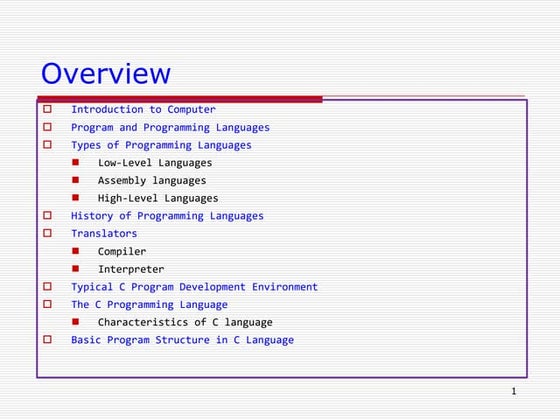



Introduction to Computerzaheeriqbal41
╠²
Introduction to Computer.
Program and Programming.
Languages.
Types of Programming Languages.
Low-Level Languages.
Assembly languages.
High-Level Languages.
History of Programming.
Languages.
Translators.
Compiler.
Interpreter.
Typical C Program Development.
Environment
The C Programming Language
Characteristics of C language
durk computer,computer clan,jim's computer,chama computer,computer gk for,tiktok computer,gaming computer,kvs computer science full syllabus,chama computers,lil durk computer,trucchi computer,bhuture computer,computer science,patwari computer,computer security,computer for uppcl,
computer business basic computer
Characteristics of C language
Basic Program Structure in C
Language
Introduction to Computer Programming (general background)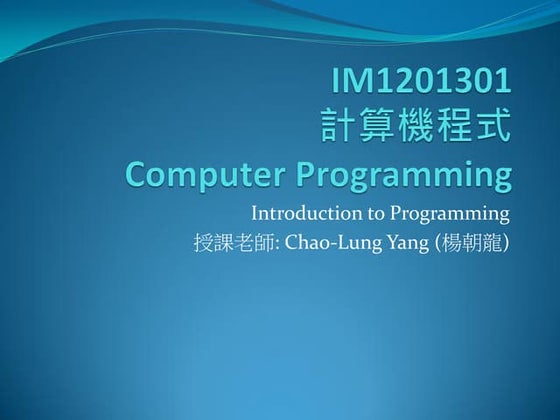



Introduction to Computer Programming (general background)Chao-Lung Yang
╠²
This document provides an introduction to programming concepts including computer programs, programming languages, execution of programs, and central processing units. It then discusses specific topics like .NET Framework, C#, and the Visual Studio integrated development environment. The key points are that computer programs are sets of instructions that direct computers, programming languages can be high-level or low-level, and Visual Studio is an IDE for developing applications using languages like C# within the .NET Framework.C Unit 1 notes PREPARED BY MVB REDDY



C Unit 1 notes PREPARED BY MVB REDDYRajeshkumar Reddy
╠²
C is a relatively low-level programming language that operates close to hardware. It was designed to be portable across various computer systems. C has small keywords, extensive library functions, and allows for low-level programming. It has become widely used due to its ability to handle both high-level and low-level activities efficiently across different computer systems. C was developed in the early 1970s at Bell Labs and the publication of The C Programming Language book popularized it further.Lecture 1



Lecture 1Tanveer Malik
╠²
Computer programming involves analyzing problems, designing algorithms, and implementing solutions as programs in a programming language. C is a widely used programming language that was originally developed for writing operating systems. C++ builds on C by adding object-oriented programming features like classes, inheritance, and templates. Both C and C++ are commonly used to develop systems software like operating systems and drivers due to their high performance.INTRO.pptx



INTRO.pptxGOBINATH KANDASAMY
╠²
C programming is a general-purpose language developed in 1972 by Dennis Ritchie to develop UNIX. It is widely used and easy to learn. C is useful for systems programming and embedded systems. To create a C program, one writes code, compiles it, and runs it to get output. C covers fundamental programming concepts like data types, variables, operators, and functions.system software and application software, compiler, interpreter & assembler



system software and application software, compiler, interpreter & assemblerchetan birla
╠²
The document discusses system software and application software. It defines system software as programs that directly interact with computer hardware to control and manage system resources, including operating systems, drivers, and development programs. Application software are programs designed for specific tasks like word processing, games, and business software. Common examples of both system and application software are provided. Compiler, interpreter, and assembler are also discussed as different types of language translators that convert source code into executable programs.Introduction to c_language



Introduction to c_languageWay2itech
╠²
The document defines what a program, application, project, and programming language are. It states that a program is a precise sequence of steps to solve a problem, an application is a collection of programs, and a project is a collection of applications. It explains that a programming language is a vocabulary and set of rules for instructing a computer to perform tasks. The document also discusses high-level, low-level, and middle-level languages and provides examples of each. Finally, it provides an introduction to the C programming language, its history, reasons for learning it, and some definitions related to C.What is software



What is softwareAnil815218
╠²
Anil, a 17-year-old student from Ghaziabad, India, introduces himself and gives a presentation about software. He defines software as a set of computer programs and documents related to operating a computer system. There are two main types of software: application software, which performs tasks for users like word processors; and system software, which manages hardware and runs applications, like operating systems. Anil discusses different types of each, including open source software that allows public access to modify code. He concludes by thanking his teacher for the opportunity and asking if anyone has any questions.Introduction to Computer, Programming languages , Networks and Internet.pptx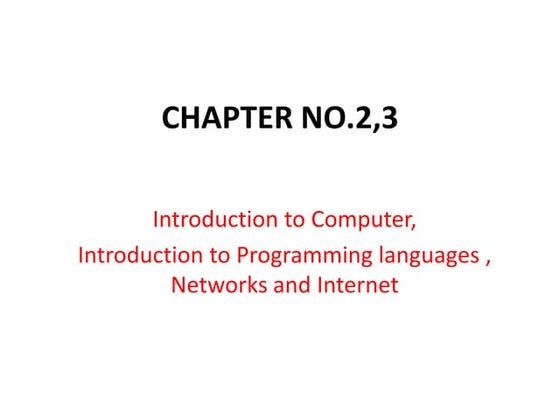



Introduction to Computer, Programming languages , Networks and Internet.pptxSheharBano86
╠²
This the ppt presentation of the field of computer scienceFundamental of Information Technology - UNIT 7



Fundamental of Information Technology - UNIT 7Shipra Swati
╠²
C Language : Basics, Constants, Variables and Data Types, Operators and Expressions,
Input & output operations.Learn c programming language in 24 hours allfreebooks.tk



Learn c programming language in 24 hours allfreebooks.tkragulasai
╠²
The first C program prints a greeting message to the screen. It includes the standard input/output header file, contains a main function that calls printf to display the message, and returns 0 at the end. The program is saved as a .c file, compiled into an executable .exe file, and run from the command prompt to output the message.Btech i pic u-1 introduction to c language



Btech i pic u-1 introduction to c languageRai University
╠²
The document provides an overview of the C programming language. It discusses the basic building blocks of a computer and how C programming works at a low level. It then covers the basic structure of a C program, including sections for documentation, definitions, global declarations, the main function, and other functions. It also defines key terms like compilers, interpreters, algorithms and flowcharts. Examples are provided to illustrate basic C programs and how they are compiled and executed.Chapter 1 Introduction to C .pptx



Chapter 1 Introduction to C .pptxAbdalla536859
╠²
A computer is an electronic device used to process data, converting the data into information that is useful to people.
A computer is a system made of two major components:
hardware and software.
The hardware is the physical equipment.
The software is the collection of programs (instruction) that allow the hardware to do the job.
introduction to c language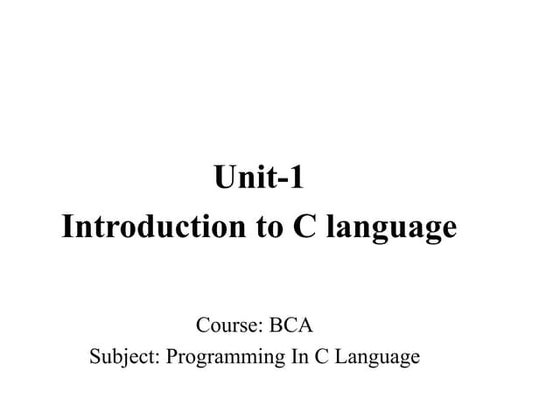



introduction to c languageRai University
╠²
The document provides an introduction to the C programming language. It discusses the basic building blocks of a computer including input, storage, processor and output. It then describes the basic structure of a C program including documentation, definition, global declaration and main sections. It provides examples of basic C programs and explains how to compile and execute a C program. Key aspects of C like data types, operators, control structures and functions are also introduced.C programming 



C programming Rohan Gajre
╠²
The document provides information about C programming language including its history, characteristics, features, program structure, control statements, preprocessor directives, header files, console I/O functions, and switch statements. C was developed by Dennis Ritchie at Bell Labs in 1972 and evolved from earlier languages like ALGOL, BCPL, and B. It is a structured, portable, and widely used language well-suited for system programming like operating systems and embedded systems.Recently uploaded (20)
"The Write Path: Navigating Research Writing, Publication, and Professional G...



"The Write Path: Navigating Research Writing, Publication, and Professional G...neelottama
╠²
To understand the meaning of publication
Test Bank Pharmacology 3rd Edition Brenner ŌĆō Stevens



Test Bank Pharmacology 3rd Edition Brenner ŌĆō Stevensevakimworwa38
╠²
Test Bank Pharmacology 3rd Edition Brenner ŌĆō Stevens
Test Bank Pharmacology 3rd Edition Brenner ŌĆō Stevens
Test Bank Pharmacology 3rd Edition Brenner ŌĆō StevensStrategic Corporate Social Responsibility: Sustainable Value Creation Fourth



Strategic Corporate Social Responsibility: Sustainable Value Creation Fourthkeileyrazawi
╠²
Strategic Corporate Social Responsibility: Sustainable Value Creation Fourth
Strategic Corporate Social Responsibility: Sustainable Value Creation Fourth
Strategic Corporate Social Responsibility: Sustainable Value Creation FourthURINE SPECIMEN COLLECTION AND HANDLING CLASS 1 FOR ALL PARAMEDICAL OR CLINICA...



URINE SPECIMEN COLLECTION AND HANDLING CLASS 1 FOR ALL PARAMEDICAL OR CLINICA...Prabhakar Singh Patel
╠²
1. Urine analysis provides important information about renal and metabolic function through physical, chemical, and microscopic examination of urine samples.
2. Proper collection, preservation and timely testing of urine samples is necessary to obtain accurate results and detect abnormalities that can indicate underlying diseases.
3. IB-Unit-4 BBA BVIMR 2022 Syllabus_watermark.pdf



IB-Unit-4 BBA BVIMR 2022 Syllabus_watermark.pdfDr. Mahtab Alam
╠²
International Business BBA 4 as per Syllabus CBCS 2022 of Bharati Vidyapeeth (Deemed to be University)How to configure the retail shop in Odoo 17 Point of Sale



How to configure the retail shop in Odoo 17 Point of SaleCeline George
╠²
Odoo's Retail Shop is managed by the module Point of Sale(POS). It is a powerful tool designed to streamline and optimize the operations of retail businesses. It provides a comprehensive solution for managing various aspects of a retail store, from inventory and sales to customer management and reporting.Analysis of Conf File Parameters in Odoo 17



Analysis of Conf File Parameters in Odoo 17Celine George
╠²
In this slide, we will analyse the configuration file parameters in Odoo 17. The odoo.conf file plays a pivotal role in configuring and managing the Odoo 17 server. It contains essential parameters that control database connections, server behaviour, logging, and performance settings.Introduction to Systematic Reviews - Prof Ejaz Khan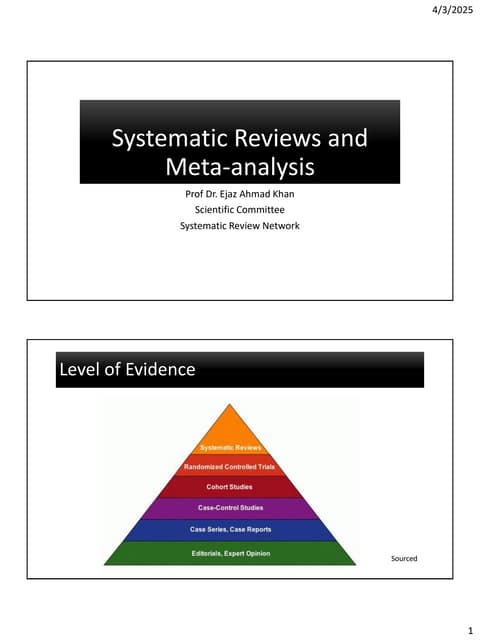



Introduction to Systematic Reviews - Prof Ejaz KhanSystematic Reviews Network (SRN)
╠²
A Systematic Review:
Provides a clear and transparent process
ŌĆó Facilitates efficient integration of information for rational decision
making
ŌĆó Demonstrates where the effects of health care are consistent and
where they do vary
ŌĆó Minimizes bias (systematic errors) and reduce chance effects
ŌĆó Can be readily updated, as needed.
ŌĆó Meta-analysis can provide more precise estimates than individual
studies
ŌĆó Allows decisions based on evidence , whole of it and not partial3. AI Trust Layer, Governance ŌĆō Explainability, Security & Compliance.pdf



3. AI Trust Layer, Governance ŌĆō Explainability, Security & Compliance.pdfMukesh Kala
╠²
AI Trust Layer, Governance ŌĆō Explainability, Security & ComplianceHow to Manage Check Out Process in Odoo 17 Website



How to Manage Check Out Process in Odoo 17 WebsiteCeline George
╠²
Checkout process is a final step before processing the purchase. At this step we review the product, add shipping details and confirm the purchase.All India Council of Skills and Vocational Studies (AICSVS) PROSPECTUS 2025



All India Council of Skills and Vocational Studies (AICSVS) PROSPECTUS 2025National Council of Open Schooling Research and Training
╠²
All India Council of Vocational Skills (AICSVS) and National Council of Open Schooling Research and Training (NCOSRT), Global International University, Asia Book of World Records (ABWRECORDS), International a joint Accreditation Commission of Higher Education (IACOHE)The prospectus is going to be published in the year 2025A-Z GENERAL QUIZ | THE QUIZ CLUB OF PSGCAS | 14TH MARCH 2025.pptx



A-Z GENERAL QUIZ | THE QUIZ CLUB OF PSGCAS | 14TH MARCH 2025.pptxQuiz Club of PSG College of Arts & Science
╠²
Behold a thrilling general quiz set brought to you by THE QUIZ CLUB OF PSG COLLEGE OF ARTS & SCIENCE, COIMBATORE, made of 26 questions for the each letter of the alphabet and covering everything above the earth and under the sky.
Explore the trivia , knowledge , curiosity
So, get seated for an enthralling quiz ride.
Quizmaster : THANVANTH N A (Batch of 2023-26), THE QUIZ CLUB OF PSG COLLEGE OF ARTS & SCIENCE, CoimbatoreAction of Muscles ppt by Priscilla Jasper Vedam Vemavarapu @ASRHMC



Action of Muscles ppt by Priscilla Jasper Vedam Vemavarapu @ASRHMCjaspervedamvemavarap
╠²
Action of muscles-Anatomy
Contraction and relaxation
Muscle tone
Length and tension relationship
Types of muscle contraction
Active and passive insufficiency
Shunt and sprunt muscles
Agonists
Antagonists
Fixators
Synergists
Unit No. 4 - Immunopharmacologyslides.pptx



Unit No. 4 - Immunopharmacologyslides.pptxAshish Umale
╠²
The branch of pharmacology concerned with the immune system. Immunopharmacology is the study of the effects of the drugs modifying immune mechanism in body. It includes not only inoculation but also autoimmune disorders, allergic reactions, and cancer. IMMUNITY is the ability of the living body or the process to resist various types of organisms or toxins that tend to damage the tissue and organs.Immunostimulants and immunomodulators are drugs that modulate the immune response and can be used to increase the immune responsiveness of patients with Immunodeficiency as in AIDS, chronic illness and cancers.
Vaccines and antisera are used for immunization against bacterial and viral infections.
Synthesized originally as an anthelmintic but appears to restore depressed immune function of B lymphocytes, T lymphocytes, monocytes and macrophages.
Interferons alpha and beta are mainly used for antiviral effects while interferon a for its immunomodulating actions.
Cyclosporine is a cyclic peptide antibiotic produced by a fungus Beauveria nivea.
Cyclosporine acts at an early stage, selectively inhibits T cell proliferation and suppresses cell-mediated immunity.
Azathioprine is a prodrug of mercaptopurine which is a purine analog.
TNFa is secreted by activated macrophages and other immune cells to act on TNF receptors (TNFR1, TNFR2) which are located on the surface of neutrophils, fibroblasts, endothelial cells as well as found in free soluble form in serum and serous fluids.
Etanercept is also used for severe/refractory ankylosing spondylitis, polyarticular idiopathic juvenile arthritis and plaque psoriasis
Anakinra along with continued MTX has been used alone as well as added to Tnfa antagonists, because its clinical efficacy as monotherapy is lower.Use of immunosuppressants is essential for successful organ transplantation.
A glucocorticoid like methylprednisolone for 3-5 days generally suppresses acute rejection episodes
Anti-Viral Agents.pptx Medicinal Chemistry III, B Pharm SEM VI



Anti-Viral Agents.pptx Medicinal Chemistry III, B Pharm SEM VISamruddhi Khonde
╠²
Antiviral agents are crucial in combating viral infections, causing a variety of diseases from mild to life-threatening. Developed through medicinal chemistry, these drugs target viral structures and processes while minimizing harm to host cells. Viruses are classified into DNA and RNA viruses, with each replicating through distinct mechanisms. Treatments for herpesviruses involve nucleoside analogs like acyclovir and valacyclovir, which inhibit the viral DNA polymerase. Influenza is managed with neuraminidase inhibitors like oseltamivir and zanamivir, which prevent the release of new viral particles. HIV is treated with a combination of antiretroviral drugs targeting various stages of the viral life cycle. Hepatitis B and C are treated with different strategies, with nucleoside analogs like lamivudine inhibiting viral replication and direct-acting antivirals targeting the viral RNA polymerase and other key proteins.
Antiviral agents are designed based on their mechanisms of action, with several categories including nucleoside and nucleotide analogs, protease inhibitors, neuraminidase inhibitors, reverse transcriptase inhibitors, and integrase inhibitors. The design of these agents often relies on understanding the structure-activity relationship (SAR), which involves modifying the chemical structure of compounds to enhance efficacy, selectivity, and bioavailability while reducing side effects. Despite their success, challenges such as drug resistance, viral mutation, and the need for long-term therapy remain.How to Invoice Shipping Cost to Customer in Odoo 17



How to Invoice Shipping Cost to Customer in Odoo 17Celine George
╠²
Odoo allows the invoicing of the shipping costs after delivery and this ensures that the charges are accurate based on the real time factors like weight, distance and chosen shipping method.URINE SPECIMEN COLLECTION AND HANDLING CLASS 1 FOR ALL PARAMEDICAL OR CLINICA...



URINE SPECIMEN COLLECTION AND HANDLING CLASS 1 FOR ALL PARAMEDICAL OR CLINICA...Prabhakar Singh Patel
╠²
All India Council of Skills and Vocational Studies (AICSVS) PROSPECTUS 2025



All India Council of Skills and Vocational Studies (AICSVS) PROSPECTUS 2025National Council of Open Schooling Research and Training
╠²
A-Z GENERAL QUIZ | THE QUIZ CLUB OF PSGCAS | 14TH MARCH 2025.pptx



A-Z GENERAL QUIZ | THE QUIZ CLUB OF PSGCAS | 14TH MARCH 2025.pptxQuiz Club of PSG College of Arts & Science
╠²
Introduction of C Programming
- 1. Asst. Professor(Computer Science) International School of Management,Patna Presented by- Dr. Ranjan Kumar Mishra History of Programming Language
- 2. Programming Language ’é© It is a tool to develop different type of software. ’é© It is a language that has been used to give instructions to the computer to perform specific task. ’é© We can develop any type of application i.e. windows-based , web-based and mobile application also . ’é© Some of the programming language supports window-based and some supports web-based .
- 3. Origin of C BCPL and B are "type less" languages whereas C provides a variety of data types. In 1972 Dennis Ritchie at Bell Labs writes C and in 1978 the publication of The C Programming Language by Kernighan & Ritchie caused a revolution in the computing world. ALGOL (1960) BCPL (1967) B (1970) C (1972) K & RC (1978) ANSI C (1989) ANSI/ISO C (1990)
- 5. What is C? C is a high-level and general purpose programming language that is ideal for developing firmware or portable applications. Originally intended for writing system software, C was developed at Bell Labs by Dennis Ritchie for the Unix Operating System (OS) in the early 1970s.
- 6. Levels of Programming Language 1 ŌĆó Low Level 2 ŌĆó High Level
- 7. Low Level Machine language Assembly language In form of 0 and 1 No need of Compiler /interpreter Uses binary as well as symbols like ADD,SUB,LOAD etc. It requires ASSEMBELE R
- 8. High Level Specific purpose General Purpose COBOL is used only for business purpose. (Common Business Oriented language) FORTRAN is used only for scientific purpose. (Formulae Translation) It provides a common platform to develop different type of software. Like C, C++, Java , .NET etc.
- 9. Types of Application Software Stand Alone Application Networking based Application Software A Software that runs on a single system at a time. Ex:- A billing Software used by the shopkeeper. A software that runs on a multiple system at a time. Ex:- A billing software used in the malls.
- 10. Utility Software ’é© It improves the function of computer infrastructure to help users performs multiple tasks efficiently. ’é© It is designed to help analyze, configure, optimize or maintain a computer and enhance the computerŌĆÖs performance. ’é© It is a program that performs a specific task, which is usually related to managing the system resources. Ex:- All antiviruses, Disk Repair, Disk Cleaner, Registry Cleaner etc.
- 11. Compiler Vs. Interpreter ŌĆó Compiler is a computer program that transforms code written in a high-level programming language into the machine code. ŌĆó It will convert the code into machine code (.exe) before program run. ŌĆó Interpreter is a computer program which converts each high level program statement into the machine code. ŌĆó It will convert code into machine code when the program is run.
- 12. ERROR Compile Time Run Time Syntax Error Semanti c Error Logical Error
- 13. Structured Programming C is a structured programing language and it follows top to bottom approach. It works on the basis on divide and conquer rule. Calculator Sum a+b Sub a-b Mul a*b
- 14. Advantage of Structured P/L It is user friendly and very easy to understand. It is easier to learn and also to maintain. They require less time to write. These are mainly problem oriented.
- 15. PDLC Algorithm Flow Chart Pseudo Code Coding/Pro gram It is a finite sequenc e of steps to solve a particula r problem. It is a pictorial representatio n of algorithm. It is an informal high level descriptio n. It is not an executable program. It can be written in any high level language
- 16. Features of C: ’üČ Structure Oriented ’üČ Platform Dependent ’üČ Compiler Based ’üČ Simple and easy to learn ’üČ Huge function library ’üČ Uses of pointer concept ’üČ Power Full ’üČ Case Sensitive
- 17. THANKS







